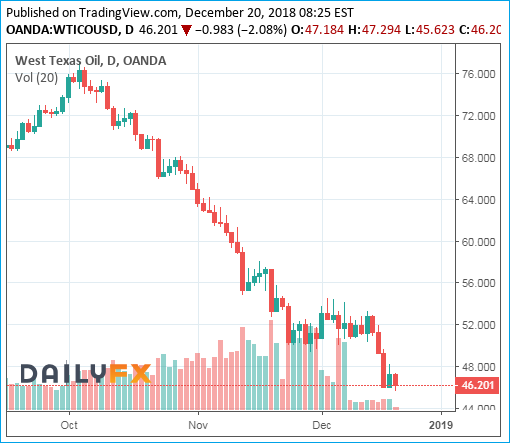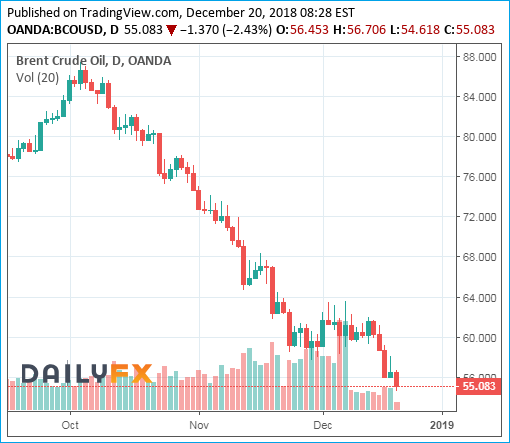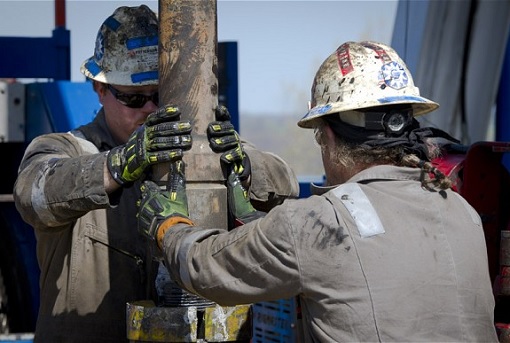International benchmark Brent crude oil broke the US$60 support level to about US$55. The American WTI, meanwhile, plunged below the US$52 psychological level to US$46 a barrel. If the U.S. crude futures contract continues to drop, we may see the oil breach the US$40 before the year end. In essence, the global oil prices are down 40% from peaks since the start of October.
American consumers gleefully watch the gas prices decline for the tenth straight week. The national average price of petrol tumbled to US$2.36 per gallon last week, the lowest since August 2017. More than 65 metro areas now feature an average price of under US$2 per gallon. And 31 states have at least one gas station selling gasoline under US$2 per gallon.
The attention has been shifted to slowing economic growth next year (2019), record oil production and, even the lack of confidence with OPEC’s pledge to curb production. The OPEC and non-OPEC allies, especially Russia, agreed this month to curb output by 1.2 million barrels per day (bpd) in an attempt to drain tanks and boost prices. But the cut fails to stop the bleeding.


Heck, even Saudi Arabia’s energy minister, Khalid al-Falih, isn’t sure if the production cut, which will not happen until next month, would be enough to fix the plunging oil prices. While he expected global oil stocks to fall by the end of the first quarter, he also admitted that the market remained vulnerable to political and economic factors as well as speculation.
That means the production cut appears to have very little effect on the prices. Instead, the oil markets are spooked by talk of a global recession and ever-present trade war fears, despite another week of declining rig counts in the United States. In addition, Alberta is to begin a pullback of 325,000 barrels of crude in less than 2 weeks. Even ongoing oil production setbacks in Libya fail to boost oil prices.
Amazingly, oil traders simply ignored news over Iranian output declining below 3 million barrels a day for the first time since the lifting of sanctions in 2015. The U.S. crude inventories fell by 497,000 barrels in the week to December 14, smaller than the decrease of 2.4 million barrels analysts had expected, suggesting that there were still massive of oil in the market.

But if you think the worst is over and the crude is going to explode to the roof, think again. Crude is actually trading at about US$40 a barrel in the west Texas region that sits atop most of the Permian Basin. Yes, the oil is selling for less than the cost of developing new wells. In fact, Midland-based WTI was trading at about US$7.25 to US$7.60 below benchmark U.S. crude prices.
How is this possible? The Permian has been pumping so much oil that not only energy companies can’t find enough workers, the surging output is also the reason the United States becomes the world’s biggest crude oil producer, producing a jaw-dropping 11 million barrels a day. However, it has also created bottlenecks – too few pipelines – to bring the oil to the market.
As a result, the oil in the region could be sold at a steep discount – 7 bucks – to benchmark U.S. West Texas Intermediate (WTI) crude futures. This year alone, the Permian production grew by about 874,000 barrels per day. Even at 40 bucks a barrel, the oil companies are not affected because they had locked in prices for future deliveries with customers well ahead of shipment.

So, the question is whether the U.S. shale producers can continue to make profit at the current crude prices for next year’s delivery. America holds the key to oil prices, not Saudi Arabia and definitely not Russia. It’s a tricky business in determining the “breakeven” price. Certain area in the Permian Basin, such as Spraberry, can breakeven between US$32 and US$47 a barrel.
However, in the best area, the breakeven can be in the low US$30s. Other unattractive area requires an average US$65.54 per barrel to break even. In short, wells in the Bakken, the Eagle Ford and the Niobrara can sell at US$40 a barrel and still make money. Hence, if they have locked in sales for 2019 production at US$60, or even at US$50 per barrel, they have absolutely nothing to worry.
Considering the crude now has dropped like a rock to the US$40s, it’s only logical for the shale producers to keep pumping in anticipation of a price rebound. It does not make sense to suddenly shut down the operation altogether. Therefore, even some are making losses, shale companies could simply keep up their pace of drilling in 2019.

Coincidentally, besides the trade war with China, President Trump also holds the key to crude prices. His administration’s desire for low oil prices is a public knowledge. Even after the oil market tumbles, he keeps harassing Saudi Arabia for lower prices. Saudi oil minister Khalid al-Falih tried to reassure the market that we will not see a repeat of the 2014-2016 meltdowns.
But the situation now is very different. Back in 2014-2016, there was no trade war between the world’s two largest economies. And the United States had not emerged as the world’s biggest crude oil producer to rival OPEC and Russia. And there was certainly no concern about an economic slowdown. OPEC can do one thing though – cut more production, and lose market share.
Other Articles That May Interest You …
- 2019 Recession May Have Started – December Stock Market Will Be The Worst Since 1931 Great Depression
- President Trump’s Trade War Strategy Against China Isn’t Working – It Gets Worse!!
- BOOM!! – Gasoline At US$1.64 A Gallon, Or RM1.80 A Litre Now
- Forget OPEC – These 3 Powerful Men Will Determine & Control The World Oil Prices
- BOOM!! U.S. Now World’s Largest Oil Producer – Oil Lost 20% In A Month, Could Drop To $40 In Bear Market
- BOOM!! – Crude Oil Prices Drop Spectacularly From Its $80 High, And Here’s Why It Will Continue To Fall
- Get Ready For 4 Rate Hikes This Year – New Fed Boss Powell Ain’t Afraid Of Stock Crash
- 30 Investing Tips & Tricks You Won’t Learn At School

|
|
December 20th, 2018 by financetwitter
|


|

|

|

|

|

|




























Comments
Add your comment now.
Leave a Reply